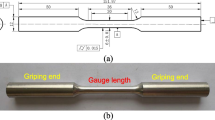Abstract
One of the failure modes observed in steel yield energy dissipating devices (SYEDs) excited by a strong earthquake would be the low-cycle fatigue failure. Fatigue cracks of a SYED are prone to initiate at the notch areas where stress concentration is usually occurred, which is demonstrated by the cyclic tests and analyses carried out for this study. Since the fatigue failure of SYEDs dramatically deteriorates their structural capacities, the thorough investigation on their fatigue life is usually required. To do this, sophisticated modeling with considering a time-consuming and complicate fracture mechanism is generally needed. This study makes an effort to investigate the low-cycle fatigue life of SYEDs predicted by a simplified method utilizing damage indices and fatigue prediction equations that are based on the plastic strain amplitudes obtained from typical finite element analyses. This study shows that the low-cycle fatigue failure of SYEDs predicted by the simplified method can be conservatively in good agreement with the test results of SYED specimens prepared for experimental validation.














Similar content being viewed by others
References
ABAQUS 6.10. (2010). Analysis user’s manual. Providence, RI: Dassault Systems Simulia Corp.
ASCE, SEI 7. (2010). Minimum design loads for buildings and other structures. VA: American Society of Civil Engineers.
ASM. (2008). Elements of metallurgy and engineering alloys. Materials Park, OH: ASM International.
Black, C. J., Makris, N., & Aiken, I. D. (2004). Component testing, seismic evaluation and characterization of buckling-restrained braces. ASCE Journal of Structural Engineering, 130(6), 880–894.
Chen, G., Wang, J., & Liu, X. (2014). Generalized equations for estimating stress concentration factors of various notch flexure hinges. ASME Journal of Mechanical Design, 136(3), 081002.
Chopra, A. K. (2012). Dynamics of structures: Theory and applications to earthquake engineering (4th ed.). Englewood Cliffs, NJ: Prentice Hall.
Coffin, L. F. (1960). The stability of metals under cyclic plastic strain. Journal of Basic Engineering, 82(3), 671–682.
Dowling, N. E. (1971). Fatigue failure predictions for complicated stress–strain histories (Vol. 337). Urbana: Department of Theoretical and Applied Mechanics, Illinois University.
Dowling, N. E. (2007). Mechanical behavior of material: Engineering methods for deformation, fracture, and fatigue (3rd ed.). NJ: Prentice Hall.
Fricke, W., Gao, L., & Paetzold, H. (2017). Fatigue assessment of local stresses at fillet welds around plate corners. International Journal of Fatigue, 101, 169–176.
Ghabraie, K., Chan, R. W. K., Huang, X., & Xie, Y. M. (2010). Shape optimization of metallic yielding devices for passive mitigation of seismic energy. Engineering Structures, 32, 2258–2267.
Hu, J. W. (2014). Investigation on the cyclic response of superelastic shape memory alloy (SMA) slit damper devices simulated by quasi-static finite element (FE) analyses. Materials, 7, 1122–1141.
Karavasilis, T. L., Kerawala, S., & Hale, E. (2012). Hysteretic model for steel energy dissipation devices and evaluation of a minimal-damage seismic design approach for steel buildings. Journal of Constructional Steel Research, 70, 358–367.
Korean Agency for Technology and Standards (KATS). (2008). Method of tensile test for metallic materials, KS B 0802. Seoul: KATS.
Krawinkler, H., & Zohrei, M. (1983). Cumulative damage in steel structures subjected to earthquake ground motions. Computers & Structures, 16(1–4), 531–541.
Manson, S. S. (1962). Discussion: Experimental support for generalized equation predicting low cycle fatigue. Transactions on ASME Journal of Basic Engineering, 84(4), 537–541.
Miner, M. A. (1945). Cumulative damage in fatigue. Journal of Applied Mechanics, Transactions ASM, 67, 159.
Nakamura, H., Maeda, Y., & Sasaki, T. (2000). Fatigue properties of practical-scale unbonded braces. Report No. 82, Nippon Steel, Japan.
Narihara, H., & Tsujlta, O. S. Y. (2002). The experimental study on buckling restrained braces. Part 4 Low Cycle Fatigue Test on Aseismic Brace with SN400B, SN490B, Architectural Institute of Japan, Japan.
Noh, D. Y. (2003). Distribution of residual stress and prediction of fatigue life of SS400 after welding, Ph.D Dissertation, Pohang University of Science and Technology, Pohang, Korea.
Oh, S. H., Kim, Y. J., & Ryu, H. S. (2009). Seismic performance of steel structures with slit dampers. Engineering Structures, 31(9), 1997–2008.
Soong, T. T., & Spencer, B. F. (2002). Supplemental energy dissipation: State-of-art and state-of-the practice. Journal of Engineering Structures, 24(3), 243–259.
Stephens, R. I., Fatemi, A., Stephens, R. R., & Fuchs, H. O. (2001). Metal fatigue in engineering (2nd ed.). New York, NY: Wiley.
Tamai, H., Kondoh, K., & Hanai, M. (1994). On low-cycle fatigue characteristics of hysteretic damper and its fatigue life prediction under severe earthquake. AIJ Journal of Structural and Construction Engineering, 462, 141–150.
Tremblay, R., Bolduc, R., Neville, R., & Devall, R. (2006). Seismic testing and performance of buckling-restrained bracing systems. Canadian Journal of Civil Engineering, 33(2), 183–198.
Tsai, K. C., Chen, H. W., Hong, C. P., & Su, Y. F. (1993). Design of steel triangular plate energy absorbers for seismic-resistant construction. Earthquake Spectra, 9(3), 505–528.
Whittaker, A. S., Bertero, V. V., Thompson, C. L., & Alonso, L. J. (1991). Seismic testing of steel plate energy dissipation devices. Earthquake Spectra, 7(4), 563–604.
Acknowledgements
This work was supported by the National Research Foundation of Korea (NRF) grant funded by the Korea government (MSIP) (No. NRF-2016R1A2B4011900).
Author information
Authors and Affiliations
Corresponding author
Rights and permissions
About this article
Cite this article
Shin, DH., Kim, HJ. Low-Cycle Fatigue Failure Prediction of Steel Yield Energy Dissipating Devices Using a Simplified Method. Int J Steel Struct 18, 1384–1396 (2018). https://doi.org/10.1007/s13296-018-0148-1
Received:
Accepted:
Published:
Issue Date:
DOI: https://doi.org/10.1007/s13296-018-0148-1




